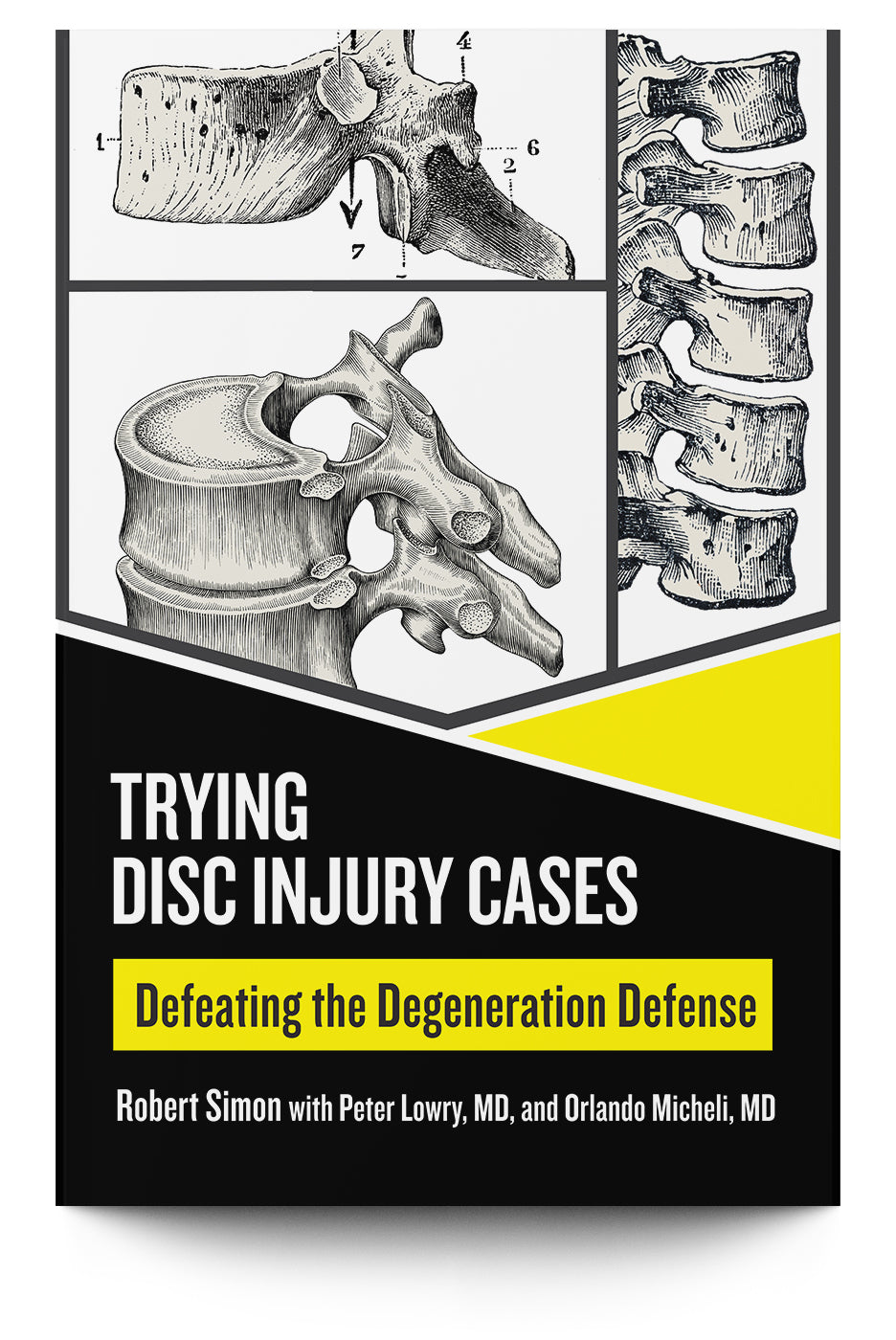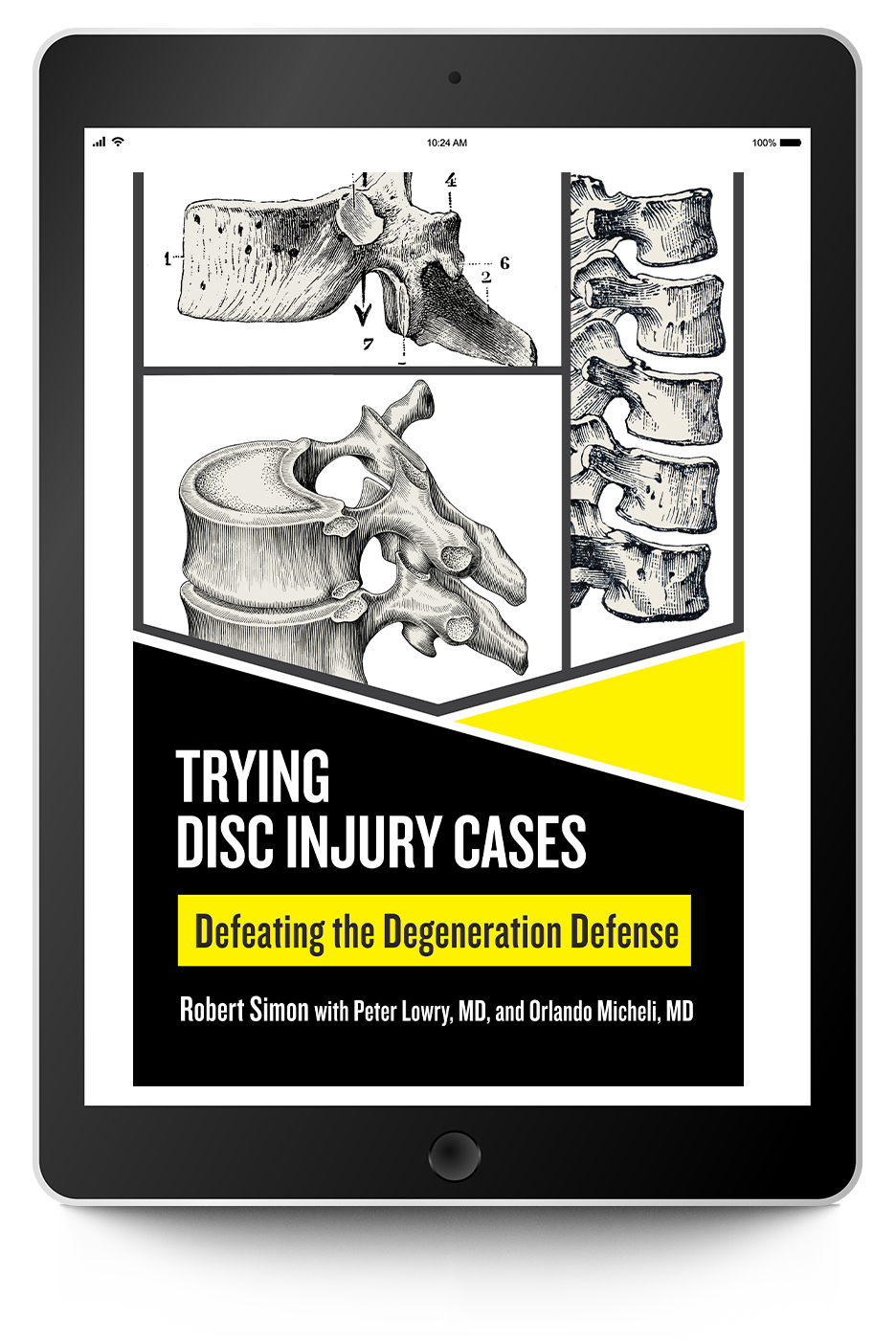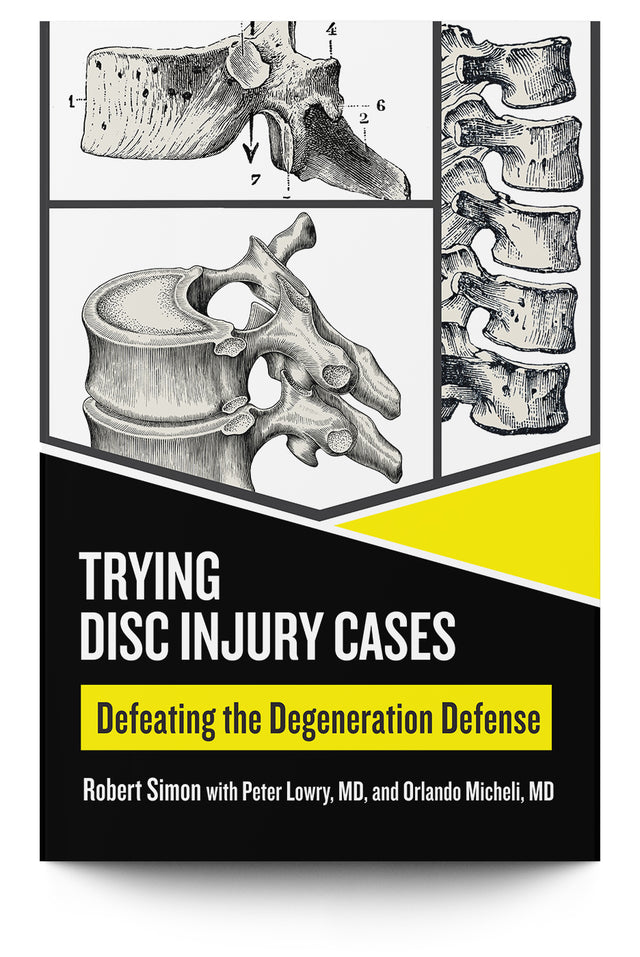Description
Description
Spinal injuries are the most common type of injury in many areas of personal injury law. In this comprehensive guide, trial lawyer Robert Simon reveals proven strategies for handling spinal disc injury litigation. Trying Disc Injury Cases: Defeating the Degeneration Defense teaches the fundamentals of the anatomy, medicine, and law involved in spinal disc injury cases.
Simon covers how to defeat the defense’s tactics, defang their experts, and discredit common arguments like claims that your client will “heal in three to six months” or that “no one can get a disc injury from this type of collision.” Offering case studies to demonstrate his approach, as well as an introduction to the necessary medicine lawyers need to understand, Simon shows how disc injury cases can lead to big wins that give your clients the justice they deserve. As Simon writes, “These cases have real value and have given me some of my largest verdicts.”
Simon’s firm has handled hundreds of spine injury cases and he has spent years developing effective strategies and learning from some of the best in the business. Simon has taken numerous spine injury cases to verdict with outcomes ranging from $500,000 to $17 million. His methods have been tested in liberal, conservative, urban, and rural jurisdictions. He’s won cases with severe to no vehicle damage (the damage in Simon’s $17 million case was “so minor you could hardly see it”), and with clients who have been anywhere from nineteen- to eighty-four-years old and from every social and economic background.
Part 1, “Developing Your Case and Anticipating the Defense,” focuses on how to build your case for trial and set yourself up to maximize settlement value for your client.
Simon is joined by two radiologists, Peter Lowry, MD, and Orlando Micheli, MD, as they walk you through an illustrated introduction to spinal anatomy and typical injuries such as fractures, disc herniations, and ligament injuries. They also cover common issues in disc injury cases, such as radicular pain, and discuss how understanding the strengths and weaknesses of X-Rays, CT scans, and MRIs can be vital to your client’s case.
Simon then moves on to case preparation, how to disarm common defenses, and exposing weaknesses in the defense’s favorite tactics. Contributing author Steve Rosen (a former defense lawyer) walks you through how defense lawyers approach cases from intake and evaluation to how they often go about defending liability, denying causation, casting doubt on your client’s injuries, and looking for inconsistencies and ways to confuse the issues in your case.
Part 2, “Witnesses in Deposition and Trial: Why Less is More” covers witnesses for the plaintiff (from your client and lay witnesses to treating doctors and experts) and the defense. Simon shows how to put on a focused case that consists of a small number of witnesses in order to appeal to jurors and hurt the defense’s ability to confuse issues and attack your case. Simon writes that it doesn’t “hurt to tell jurors in jury selection: ‘Would you hold it against us if we only use one witness to prove a fact, and shorten this trial?’ Usually, this is met with laughter from the panel.”
Simon also offers strategies for dealing with specific defense experts such as radiologists, biomechanical experts, and billing experts. He includes deposition and trial transcripts to demonstrate how to counter these defense experts, both before and during trial. He also breaks down how to neutralize common red herrings the defense likes to use to blame your client’s pain and need for treatment on other issues that your client may have.
Part 2 ends with tactics for turning the defense’s own words against them and using pretrial motions to handle potential issues like video surveillance, mentions of attorney-referred care and liens, and alternate causation theories.
Part 3, “The Trial,” covers how to effectively tell your client’s story and make the jury want to fight for them. Simon covers specific topics related to voir dire, opening statement, plaintiff’s direct examination, cross-examination (including preparing your client), and closing arguments. Using outlines and examples, Simon demonstrates strategies for putting on a successful case at trial that sets you up to win full justice for your client.
The book also includes an appendix with a full glossary of medical terms commonly found in disc injury cases, an extensive sample outline for a plaintiff’s direct examination, and Dr. Orlando Micheli provides unique insights into how radiologists diagnose patients and the criteria experts consider when offering opinions in disc injury cases.
Throughout Trying Disc Injury Cases, Robert Simon shares the roadmap he has used to repeatedly win just results and build a successful practice founded on understanding clients’ specific injuries, disarming the landmines the defense attempts to place throughout litigation, and helping tell clients’ complete stories at trial. This book is intended to provide you with both the foundation to work on disc injury cases as well as insights into the nuances that ultimately bring home the big verdicts.
This guide is essential for personal injury attorneys who handle spinal disc injury cases.
Your eBooks are now accessible from your Trial Guides account! Click here for step by step instructions.
Do you want the eBook and print book? After you complete your purchase of the print book you will receive a coupon code via email to purchase the eBook for $20.
Author
Author
Details
Details
Paperback: 400 pages; 1st Edition; ISBN: 978-1-951962-72-2
Publisher: Trial Guides LLC
Table of Contents
Table of Contents
Foreword
Acknowledgments
- Robert Simon
- Orlando Micheli, M
- Peter Lowry, M
Publisher's Note
Introduction
- Getting Results
- Flow of this Book
Educating Yourself About Medicine
- Watch Depositions
- Conference Learning
- Other Sources
- Books and Videos
- Papers
About the Cases in This Book
- Michael Johnson v. Jonathan Brown
- Paulina Atlantic v. B&D Transport
Part 1: Developing Your Case and Anticipating the Defense
- Spine 101
- Introduction to the Spine
- Bones in the Spine
- The Spinal Canal
- Spinal Injuries
- Fractures
- Disc Injuries
- Disc Herniations
- Disc Protrusion
- Disc Extrusion
- Disc Sequestration
- Radiculopathy and Radicular Pain
- Ligament Injuries
- Takeaways
- Introduction to the Spine
- Diagnosing Spine Injuries
- Picture This: Imaging Explained
- X-Ray
- CT Scan (Computerized Tomography)
- MRI (Medical Resonance Imaging)
- More About MRIs
- The T1 Sequence
- The T2 Sequence
- The STIR (Short Tau Inversion Recovery) Sequence
- Takeaways
- Picture This: Imaging Explained
- Building Your Spine Case Through Science
- Seeing Through X-Rays and MRIs
- General Spine Reports: Size Doesn't Matter
- Impingement and Stenosis
- Herniation and Bulge
- Instability from Ligament Damage
- Wear-and-Tear and Trauma
- Radiculopathy and the Dermatome Map
- Takeaways
- Common Defense Arguments
- If the Car Isn't Hurt, the Person Can't Be Hurt
- Gaps in Treatment
- Unimpressive MRI Findings
- Your Client is a Liar!
- That Single Unfavorable Medical Record
- Attorney-Referred Care: Your Doctors Aren't Frauds
- Takeaways
- Teaching an Old Defense Attorney New Tricks
- Defense Intake and Initial Evaluation
- Defend Liability
- Deny Causation and Doubt Injuries
- Find Inconsistencies and Confuse the Issues
- Telling Your Client's Story
- Identifying a Theme
- Identify Jury Instructions Early
- Takeaways
- Gathering the Evidence
- Before and After Damages Photos
- Medical Timeline
- Surgery Illustrations and Reports
- Past Medical Bill Chart
- Diagnostic Imaging
- Takeaways
Part 2: Witnesses in Deposition and Trial: Why Less is Always More
- Treating Doctors
- Recommended Care Team
- Strategic Use of Video Depositions
- Treating Doctors
- Other Types of Treating Doctors
- Takeaways
- Defense Experts
- Research the Defense Experts
- Examples from Deposition and Trial
- Takeaways
- Deposing Defense Doctors
- Deposition Outline
- The Million-Dollar Question
- Ask Clear and Usable Questions
- Defense Radiologists: Turn to the Light
- Deposing or Cross-Examining Radiologists
- Takeaways
- Defense Biomechanical Experts
- How to Exclude a Defense Biomechanical Expert
- Outline for Cross-Examining Biomechanical Experts
- Takeaways
- Defense Medical Billing Experts
- Deposing the Billing Expert
- Examples: Working with Defense Billing Experts
- Takeaways
- Responding to Defense Doctors
- Red Herring #1: Other Fall at Home
- Red Herring #2: Degeneration
- Red Herring #3: Hurt at Work
- Red Herring #4: Hurt in Another Crash
- Takeaways
Part 3: The Trial
- Pretrial Motions
- Excluding Video Surveillance
- Excluding Mentions of Attorney-Referred Care and Liens
- Excluding Alternate Causation Theories
- Takeaways
- Venues, Jury Pools, and Voir Dire
- Jury Selection
- The Defense's Themes
- Takeaways
- Opening Statement
- Example: TheAtlantic Case
- Takeaways
- Plaintiff Direct Examination
- Basic Direct Exam Outline
- Pointers for Plaintiff's Direct Exam
- Preparing My Client for Cross-Examination
- Example: The Johnson Case
- Takeaways
- Cross-Examination
- Closing Argument
- Closing in Three Parts
- Rebuttal
- Example: The Atlantic Case
- Takeaways
Conclusion
Appendix A: Outline for Plaintiff's Direct Examination
- Themes
- Introduction and Main Point
- Background
- Crash Facts
- Treatment
- Current State of Health
- General Damages—Work
- Walking, Hiking, and Active Travel
Appendix B: A Deeper Look into the Radiology Room
- Diagnostic Errors in Radiology
- A Look at Radiologist Training
- Pressure on Radiologists
- The Four Points of Detective Work
- 1. The Clinical Record
- Completeness
- Making Notes of the Clinical Record
- 2. Imaging
- Image Formats
- Reviewing the Imaging
- Why Review the Clinical Record First?
- 3. Minimally Invasive Procedural Information
- Epidural Steroid Injection
- See the Imaging
- Was This the Right Procedure?
- 4. Surgical Information
- Example: Lower Lumbar Spine Injury
- Summary
- 1. The Clinical Record
- Clinical versus Non-Clinical Radiologists
- Find a Clinical Radiologist for Your Expert
- Conclusion
Appendix C: Glossary of Medical Terms
- Directional Terms
- Spine Anatomy Terms
About the Author
About the Physician Authors
What Legal Leaders Are Saying
— Mauro Fiore, Jr., Consumer Attorneys Association of Los Angeles Board Member, Dordick Trial College Board Member, voted Super Lawyer, and Running with the Bulls contributing authorThis is a monumental work that is a must-have for all trial lawyers who handle disc cases. Never has a book taken such a deep dive into the reasons why, and how, the defense approaches our cases with the degenerative defense. [Simon] doesn't hold back and shares all of his battle-tested methods to defeat this classic defense tactic.
— Hon. John M. Pacheco (retired), mediator with over four decades of experience in civil and family lawRobert Simon is brilliant! This is a must-read for any lawyer representing a client who sustained a disc injury. Not only does he meticulously explain what to expect from the defense, but more importantly, Mr. Simon gives you invaluable gems on how to empower the trier of fact favorably for your client. Well done Mr. Simon!
— Hon. Jacqueline A. Connor (retired), mediator and arbitrator with over 25 years of judicial experience in resolving complex legal and factual issuesIf you’re seeking expert tips from someone who truly understands the day-to-day realities of the trenches in today’s courtrooms, Bob Simon is an invaluable resource. His working-class background and personal experiences lend him exceptional credibility with jurors. His advice is both practical and substantive, grounded in the recognition that courtroom dynamics often differ significantly from what’s on paper. He knows what he’s talking about. Take heed.
— Andrew Garza, partner and trial attorney at Claggett, Sykes & Garza, LLCWhile spinal injuries can affect the literal bones in a back, they inflict greater harm on the ‘backbones’ in our communities who work hard each day to show up and support their loved ones. Disc injuries have long been the target of tort reform narratives and dishonest defenses relying on junk science. Our clients are called liars and malingerers simply because their injuries exist beneath the surface of the skin, invisible to the naked eye. Simon’s book is the antidote. This book thoroughly examines the strategies employed in disc injury cases and provides a clear framework for dismantling dishonest defenses. Simon excels at distilling complex medical concepts into digestible lessons for every attorney, reinforcing the critical point that there is no substitute for hard work and knowing the medicine. This book is essential reading for any trial lawyer interested in mastering the medicine and has become required reading for every new lawyer I hire.
— Carol O. Cadiz, attorney at O'Connor Cadiz Accident and Injury LawThis book should be required reading for every plaintiff’s personal injury attorney. Most injured car crash victims suffer from exactly the type of injuries covered in this book. Most personal injury attorneys are also not doctors. The book very successfully bridges the gap with practical, real-world tips on how to defeat the insurance company’s nonsense and succeed in spinal injury/chronic pain cases. Thank you, Mr. Simon, for writing such a practical and well-written book.
— Jennifer Gore, founder and attorney at Atlanta Personal Injury Law GroupBob Simon masterfully outlines the common tactics defense attorneys use to downplay the value of cases, targeting both clients and plaintiff's attorneys. In his signature no-nonsense style, Bob debunks these myths with clarity and precision, delivering a powerful message that makes you realize just how much more these cases are truly worth. I particularly appreciate his straightforward approach in dismantling the insurance companies' nonsense—it's refreshing and packed with facts that make you say, ‘Yes, this case is worth far more.
— Hon. Joe W Hilberman (retired), LA Daily Journal Top Neutrals and Los Angeles Chapter ABOTA Jurist of the Year for 2008Robert Simon’s new book on litigating disc injury cases is a very easy, informative read. The straightforward discussion and analysis of the tactics of successfully litigating a case provides good advice to plaintiff and defense counsel, such as the importance of truly understanding the nature of the injuries and keeping the presentation to the jury simple and understandable. While at times disparaging of defense counsel and insurance companies (he is, after all, a plaintiff’s attorney), the book provides insight into ‘how to’ litigate a case, with valuable suggestions for both plaintiff and defense counsel who try those cases. Plaintiff attorneys will gain valuable techniques and approaches, and defense counsel will be better armed to defend a case by educating themselves on them.





